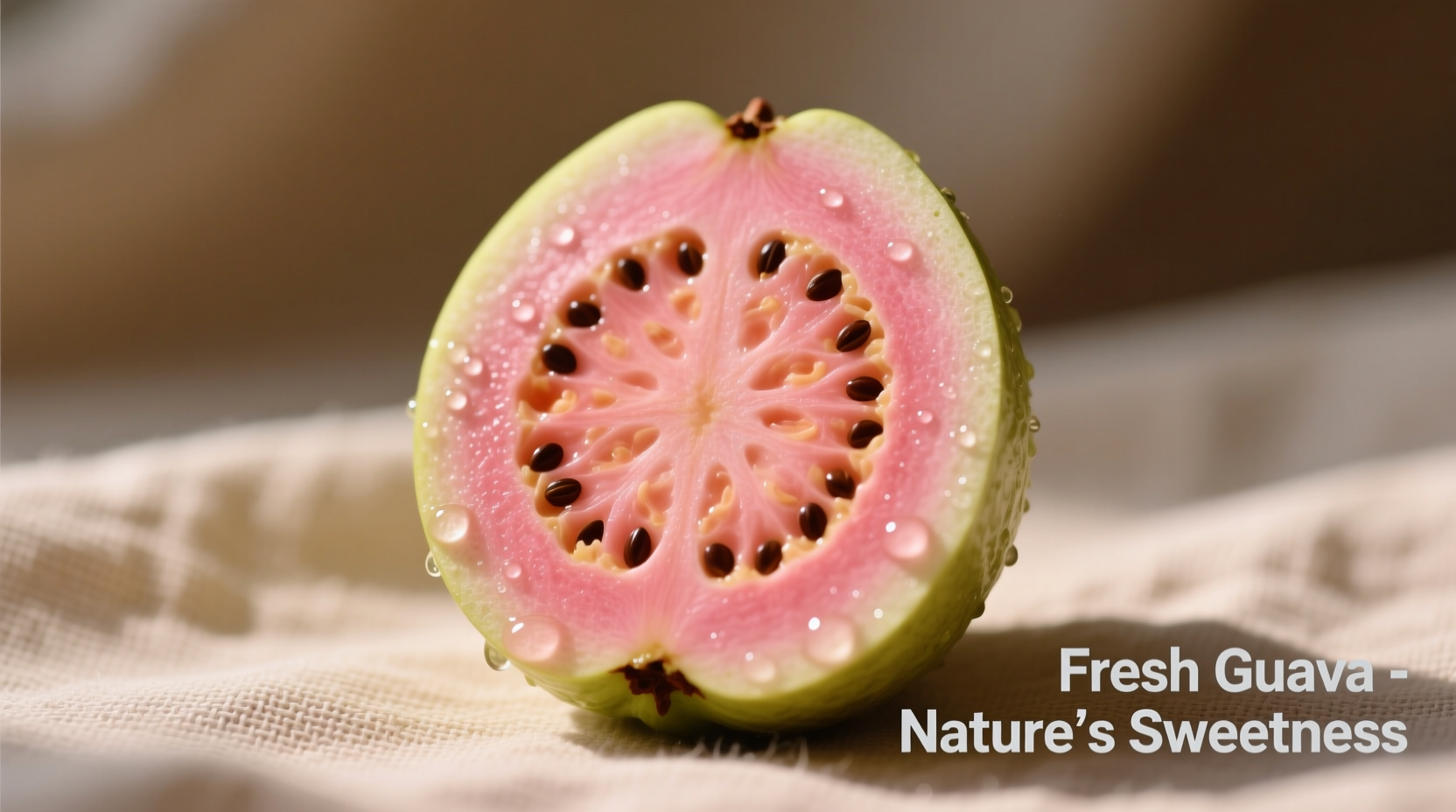Discovering Guava's Unique Flavor Journey
When you bite into a perfectly ripe guava, you're experiencing one of nature's most intriguing flavor combinations. This tropical fruit creates a sensory experience that evolves as you eat it, starting with floral sweetness that gradually reveals subtle tartness. Unlike many fruits with singular flavor profiles, guava delivers multiple taste dimensions that change based on ripeness, variety, and even growing conditions.
How Ripeness Transforms Guava's Taste Profile
The most dramatic factor affecting guava's flavor is ripeness. Understanding this transformation helps you select guavas that match your taste preferences:
| Ripeness Stage | Flavor Characteristics | Texture | Best Uses |
|---|---|---|---|
| Firm & Green | Sharp, tangy, high acidity | Crisp, crunchy | Salads, pickling, chutneys |
| Yielding to Pressure | Balanced sweet-tart, floral notes | Soft but maintains shape | Eating raw, smoothies |
| Very Soft & Fragrant | Intensely sweet, complex floral notes | Almost custard-like | Desserts, preserves, juices |
According to agricultural research from the University of Florida's Tropical Research and Education Center, the sugar-to-acid ratio in guavas shifts dramatically during ripening, with total soluble solids increasing from 4-6°Brix in unripe fruit to 10-14°Brix in fully ripe specimens (trec.ifas.ufl.edu). This scientific measurement confirms what guava enthusiasts have long known—the fruit's flavor complexity deepens significantly as it matures on the tree.

White vs. Pink Guava: Flavor Comparison
While both varieties share guava's characteristic flavor foundation, notable differences exist:
- White Guava (Psidium guajava): Features a milder, sweeter profile with pronounced pear-like notes. Common in Southeast Asia, these guavas often have a creamier texture and less pronounced floral elements.
- Pink Guava (Strawberry Guava): Delivers a more intense, complex flavor with stronger strawberry and passion fruit notes. The higher lycopene content contributes both to the pink color and slightly more tart experience.
Food scientists at Brazil's Embrapa Tropical Agroindustry research unit have documented that pink guavas contain approximately 25% more volatile aromatic compounds than white varieties, explaining their more intense fragrance and flavor perception (www.embrapa.br/en).
Texture Elements That Define the Guava Experience
Guava's taste experience extends beyond pure flavor to include distinctive textural components:
- Seeds: The numerous small, hard seeds create a pleasant crunch that contrasts with the soft flesh. Some varieties have softer seeds that become almost imperceptible when fully ripe.
- Skin: Thinner than apple skin but more substantial than peach skin, guava skin adds an earthy, slightly astringent note when eaten. Many cultures prize the skin's additional fiber and nutrients.
- Flesh Consistency: Ranges from crisp and apple-like in underripe fruit to meltingly soft in overripe specimens, with a unique fibrous quality that distinguishes it from similar fruits.
How Guava Compares to Familiar Fruits
If you're wondering what does guava fruit taste like in relation to fruits you already know, consider these comparisons:
- Strawberry + Pear Hybrid: The most common description combines strawberry's sweetness with pear's mild floral notes.
- Tropical Apple: Some detect apple-like qualities with a tropical twist, especially in less ripe guavas.
- Subtle Passion Fruit Undertones: Particularly in pink varieties, a background note reminiscent of passion fruit emerges.
- Mild Pineapple Comparison: While less acidic than pineapple, guava shares some tropical fruit characteristics without the mouth-puckering effect.
Seasonal and Regional Flavor Variations
Guava's taste isn't consistent year-round or across growing regions. Understanding these variations helps you select the best fruit:
- Seasonal Peak: In most tropical regions, guava reaches optimal flavor during dry seasons when sugar concentration increases. The University of Hawaii's College of Tropical Agriculture notes that guavas harvested in winter months typically have higher brix levels and more complex flavor profiles.
- Soil Impact: Volcanic soils produce guavas with more pronounced mineral notes, while sandy soils yield sweeter, more floral varieties.
- Cultural Preparation Methods: In Mexico, guavas are often eaten with chili powder which enhances sweetness perception, while in Southeast Asia, they're commonly paired with salt to balance acidity.
Maximizing Guava Flavor in Your Kitchen
Whether you're enjoying guava raw or incorporating it into recipes, these professional tips help you experience its best qualities:
- Ripening Technique: Place firm guavas in a paper bag with a banana to accelerate ripening through ethylene gas exposure.
- Cutting Method: Slice rather than dice to preserve the fruit's delicate structure and prevent excessive juice loss.
- Flavor Pairings: Complement guava's profile with citrus zest, fresh mint, or mild cheeses like ricotta that won't overpower its subtle notes.
- Temperature Matters: Chill guavas before eating to enhance sweetness perception—cold temperatures reduce our ability to detect acidity.
Common Guava Flavor Misconceptions
Several myths persist about guava's taste that deserve clarification:
- "Guava tastes like bubblegum": While some artificial bubblegum flavors mimic guava, authentic guava has far more complexity than the simplified candy version.
- "All guavas are extremely sweet": Properly ripe guavas balance sweetness with acidity; overly sweet guavas often indicate overripeness or inferior varieties.
- "Guava skin is bitter and inedible": When fully ripe, guava skin contributes pleasant earthy notes and valuable nutrients—many tropical cultures consider it an essential part of the eating experience.











 浙公网安备
33010002000092号
浙公网安备
33010002000092号 浙B2-20120091-4
浙B2-20120091-4